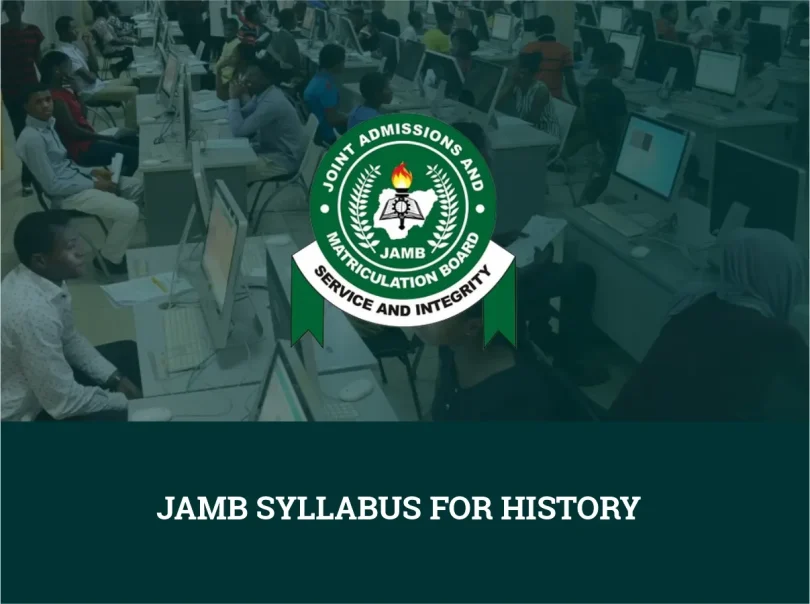The JAMB History syllabus acts as a guide through this exploration, outlining the key topics and learning objectives that candidates need to grasp. The JAMB Syllabus for History covers significant historical milestones, cultural developments, and political transformations, providing a comprehensive framework for understanding the complexities of human societies.
Engaging with the JAMB Syllabus for History allows students to approach their studies with clarity and purpose. It highlights the areas of focus, enabling efficient allocation of study time and resources.
By adhering to the JAMB Syllabus for History, candidates can build a solid foundation of historical knowledge, develop critical thinking skills, and prepare effectively for the examination.
Outline of the JAMB Syllabus for History
Below is a structured outline of the JAMB History syllabus, presented in a table format for clarity. This syllabus is designed to guide candidates preparing for the Unified Tertiary Matriculation Examination (UTME) in History, covering key topics and objectives.
| Section | Topics | Objectives |
|---|---|---|
| A. The Nigeria Area up to 1800 | Land and Peoples of the Nigeria Area<br>2. Early Centres of Civilization<br>3. Origin and Formation of States in the Nigeria Area<br>4. Economic Activities and Growth of States<br>5. External Influences | Identify geographical zones and their peoples<br>- Examine significance of early civilizations (e.g., Nok, Ife, Benin)<br>- Understand origins and structures of early states<br>- Analyze economic activities and their impact<br>- Assess external influences on Nigerian societies |
| B. The Nigeria Area 1800–1900 | The Sokoto Caliphate<br>2. Kanem-Borno<br>3. Yorubaland<br>4. Benin<br>5. Nupe<br>6. Igbo<br>7. Efik<br>8. European Penetration and Impact<br>9. British Conquest of the Nigerian Area | Explore the rise and administration of major states<br>- Understand inter-state relations and conflicts<br>- Analyze the impact of European contact and colonization |
| C. Nigeria 1900–1960 | Colonial Administration up to 1914<br>2. Colonial Administration after the Amalgamation<br>3. The Colonial Economy<br>4. Social Development under Colonial Rule<br>5. Nationalism | Examine colonial policies and their effects<br>- Understand economic and social changes during colonial rule<br>- Trace the growth of nationalist movements |
| D. Nigeria Since Independence | The First Republic and Military Intervention<br>2. The Second Republic<br>3. Nigeria in International Organizations | Analyze political developments post-independence<br>- Understand Nigeria’s role in global affairs |
| E. Africa and the Wider World Since 1800 | Egypt under Mohammed Ali and Khedive Ismail<br>2. Islamic Reform Movements and State Building in West Africa<br>3. The Mahdi and Mahdiyya Movement in the Sudan<br>4. Sierra Leone<br>5. Liberia<br>6. Ethiopia in the 19th Century<br>7. The Mfecane<br>8. The Great Trek<br>9. The Omani Empire<br>10. Patterns of Colonial Rule in Africa<br>11. Apartheid in South Africa<br>12. Colonialism and Problems of Nation-Building in Africa | Understand significant historical developments across Africa<br>- Analyze the impact of colonialism and resistance movements<br>- Evaluate post-colonial challenges and nation-building efforts |
Recommended JAMB Textbooks for History
Here are some of the recommended textbooks:
- Abba, A. (2006): The Politics of Mallam Aminu Kano, Kaduna Vanguard and Publishers.
- Ayandele, A. E. et al. (1986): The Making of Modern Africa, The Twentieth Century Vol. 2, Longman.
- Ajayi and Crowther (1971 & 1974): History of West Africa Vols. I & II, Longman.
- Akinloye, S. A. (1976): Emergent African States: Topics in Twentieth Century African History, Longman.
- Akinyemi, A. B., Agbi, S. O., and Otunbanjo, A. O. (1989): Nigeria since Independence: The First 25 Years (International Relations) Vol. X, Heinemann.
- Anene, J. C. and Brown, G. (1966): Africa in the 19th and 20th Centuries, University Press.
- Anene, J. C. (1966): Southern Nigeria in Transition, 1885–1906, Cambridge University Press.
- Ashiwaju, A. I., Croder, M., and Denzer, I. R. (Eds.): Tarikh 25, Grassroots Leadership in Colonial West Africa, Vol. 7, Longman.
- Atanda, J. A., Ashiwaju, G., and Abubakar, Y. (1989): Nigeria since Independence: The First Years: Religion Vol. I, Heinemann.
- Barkindo, B. et al. (1989 & 1996): Africa and the Wider World, Vols. 1–3, Longman.
- Boahen, A. (1969): The Revolutionary Years: Africa since 1800, Longman Publishers.
- Sokoto Caliphate: History and Legacies, 1804–2004, Vols. I and II, Arewa House.
Conclusion
Preparing for the JAMB History examination requires a thorough understanding of historical events, figures, and themes. To aid in this preparation, the Joint Admissions and Matriculation Board (JAMB) has recommended a selection of textbooks that comprehensively cover the syllabus.
These resources delve into various aspects of Nigerian, African, and global history, providing candidates with the necessary knowledge to excel in the examination.







Leave a Comment